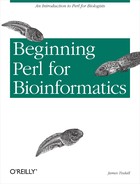In this chapter you will begin to write Perl programs that manipulate biological sequence data, that is, DNA and proteins. Once you have the sequences in the computer, you'll start writing programs that do the following with the sequence data:
Transcribe DNA to RNA
Concatenate sequences
Make the reverse complement of sequences
Read sequence data from files
You'll also write programs that give information about your sequences. How GC-rich is your DNA? How hydrophobic is your protein? You'll see programming techniques you can use to answer these and similar questions.
The Perl skills you will learn in this chapter involve the basics of the language. Here are some of those basics:
Scalar variables
Array variables
String operations such as substitution and translation
Reading data from files
The majority of this book deals with manipulating symbols that represent the biological sequences of DNA and proteins. The symbols used in bioinformatics to represent these sequences are the same symbols biologists have been using in the literature for this same purpose.
As stated earlier, DNA is composed of four building blocks: the nucleic acids, also called nucleotides or bases. Proteins are composed of 20 building blocks, the amino acids, also called residues. Fragments of proteins are called peptides. Both DNA and proteins are essentially polymers, made from their building blocks attached end to end. So it's possible to summarize the primary structure of a DNA molecule or protein by simply giving the sequence of bases or amino acids.
These are brief definitions; I'm assuming you are either already familiar with them or are willing to consult an introductory textbook on molecular biology for more specific details. Table 4-1 shows bases; add a sugar and you get the nucleosides adenosine, guanosine, cytidine, thymidine, and uridine. You can further add a phosphate and get the nucleotides adenylic acid, guanylic acid, cytidylic acid, thymidylic acid, and uridylic acid. A nucleic acid is a chemically linked sequence of nucleotides. A peptide is a small number of joined amino acids; a longer chain is a polypeptide. A protein is a biologically functional unit made of one or more polypeptides. A residue is an amino acid in a polypeptide chain.
For expediency, the names of the nucleic acids and the amino acids are often represented as one- or three-letter codes, as shown in Table 4-1 and Table 4-2. (This book mostly uses the one-letter codes for amino acids.)
Table 4-2. Standard IUB/IUPAC amino acid codes
|
One-letter code |
Amino acid |
Three-letter code |
|---|---|---|
|
A |
Alanine |
Ala |
|
B |
Aspartic acid or Asparagine |
Asx |
|
C |
Cysteine |
Cys |
|
D |
Aspartic acid |
Asp |
|
E |
Glutamic acid |
Glu |
|
F |
Phenylalanine |
Phe |
|
G |
Glycine |
Gly |
|
H |
Histidine |
His |
|
I |
Isoleucine |
Ile |
|
K |
Lysine |
Lys |
|
L |
Leucine |
Leu |
|
M |
Methionine |
Met |
|
N |
Asparagine |
Asn |
|
P |
Proline |
Pro |
|
Q |
Glutamine |
Gln |
|
R |
Arginine |
Arg |
|
S |
Serine |
Ser |
|
T |
Threonine |
Thr |
|
V |
Valine |
Val |
|
W |
Tryptophan |
Trp |
|
X |
Unknown |
Xxx |
|
Y |
Tyrosine |
Tyr |
|
Z |
Glutamic acid or Glutamine |
Glx |
The nucleic acid codes in Table 4-1 include letters for the four basic nucleic acids; they also define single letters for all possible groups of two, three, or four nucleic acids. In most cases in this book, I use only A, C, G, T, U, and N. The letters A, C, G, and T represent the nucleic acids for DNA. U replaces T when DNA is transcribed into ribonucleic acid (RNA). N is the common representation for "unknown," as when a sequencer can't determine a base with certainty. Later on, in Chapter 9, we'll need the other codes, for groups of nucleic acids, when programming restriction maps. Note that the lowercase versions of these single-letter codes is also used on occasion, frequently for DNA, rarely for protein.
The computer-science terminology is a little different from the biology terminology for the codes in Table 4-1 and Table 4-2. In computer-science parlance, these tables define two alphabets , finite sets of symbols that can make strings. A sequence of symbols is called a string. For instance, this sentence is a string. A language is a (finite or infinite) set of strings. In this book, the languages are mainly DNA and protein sequence data. You often hear bioinformaticians referring to an actual sequence of DNA or protein as a "string," as opposed to its representation as sequence data. This is an example of the terminologies of the two disciplines crossing over into one another.
As you've seen in the tables, we'll be representing data as simple letters, just as written on a page. But computers actually use additional codes to represent simple letters. You won't have to worry much about this; just remember when using your text editor to save as ASCII, or plain text.
ASCII is a way for computers to store textual (and control) data in their memory. Then when a program such as a text editor reads the data, and it knows it's reading ASCII, it can actually draw the letters on the screen in a recognizable fashion because it's programmed to know that particular code. So the bottom line is: ASCII is a code to represent text on a computer.[1]
[1] A new character encoding called Unicode, which can handle all the symbols in all the world's languages, is becoming widely accepted and is supported by Perl as well.
